|
|
|
Sort Order |
|
|
|
Items / Page
|
|
|
|
|
|
|
| Srl | Item |
| 1 |
ID:
132212
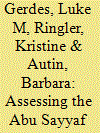

|
|
|
|
|
| Publication |
2014.
|
| Summary/Abstract |
It remains unclear whether the Abu Sayyaf Group (ASG) is a well-structured terror organization that poses a strategic threat, or a loosely organized collection of bandits that poses limited risk. Efforts to assess the nature of the organization are complicated by flaws in existing datasets on Violent Non-State Actors (VNSAs). ASG's role in kidnappings serves as a test-case to estimate incongruities among four major datasets on VNSAs. Original data collected at the agent level provides an additional point of comparison and also serves to test the efficacy of ASG's knowledge-dissemination structures, which are key in determining VNSAs' strategic capacities.
|
|
|
|
|
|
|
|
|
|
|
|
|
|
|
|
| 2 |
ID:
139503
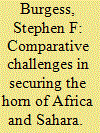

|
|
|
|
|
| Summary/Abstract |
Geography helps to explain why violent extremist organizations are difficult to counter; vast ungoverned spaces combined with weak states make it nearly impossible to decisively defeat them. However, partial success has been achieved by the United States in the Horn of Africa with a strategy of training, equipping, and supporting African intervention forces and attacking extremist leaders. In contrast, a strategy of containment in the Sahara, focusing on counterterrorism training for regional security forces and countering extremist ideology, did not succeed in preventing militant groups from taking over northern Mali and expanding their activities to other parts of the region.
|
|
|
|
|
|
|
|
|
|
|
|
|
|
|
|
| 3 |
ID:
164154


|
|
|
|
|
| Summary/Abstract |
Sectarian militants have for years launched attacks from Pakistan across the border to Iran. Finding sanctuary in a neighbouring country can make the difference between success and failure for militants. Conventional wisdom holds that a lasting transnational militancy challenge would typically create serious interstate conflict. Militancy has triggered armed encounters between Iran and Pakistan. This article argues that despite some tension militancy has resulted in deeper cooperation in the ambivalent dyad. Both states’ overarching security concerns, having exhausted other options, the believed involvement of third-party states, and economic potential, have moderately alleviated negative pressure caused by militancy.
|
|
|
|
|
|
|
|
|
|
|
|
|
|
|
|
| 4 |
ID:
181957
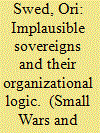

|
|
|
|
|
| Summary/Abstract |
The havoc and disarray among governments and societies caused by the COVID-19 outbreak also invited opportunities for violent non-state actors to exploit for their advantage governments’ failure to provide an adequate public health response or their denigration of security apparatuses due to the outbreak. Focusing on the early months of the outbreak, this study examines three courses of actions taken by those actors and the potential explanation for the variation in responses. The responses examined are actors offering COVID-related public health response as a surrogate for the state, the extension of hostilities, and the request for a ceasefire. Looking at a sample of 72 groups we suggest that the actors’ governance levels, which dictate their organizational logic and behavior, are strong predictors for the likelihood of them offering public health support, conduct attacks, or pursues a ceasefire during the period examined.
|
|
|
|
|
|
|
|
|
|
|
|
|
|
|
|
| 5 |
ID:
144345
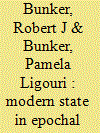

|
|
|
|
|
| Summary/Abstract |
This article is intended to serve as a ‘think piece’ which invites readers to view current perceived changes to the conduct of modern warfare in the broader historical light outlined by proponents of epochal change theory. Neo-medievalists have gone a step in this direction and posited that these changes represent the future of warfare and are evidence of a return, in a sense, to the primary tenets of political and social organization that existed in the period commonly referred to as the Middle Ages. The contention herein is that the answer gains more accuracy if one takes a much longer historical standpoint beginning with classical civilization and moving through the medieval period to our modern world. With regard to the present, this epochal warfare analysis projects that a shift from a Westphalian to post-Westphalian global system is underway. During this period of transition – as in the transition periods between epochs which have preceded it – the dominant state form undergoes a deinstitutionalization process, and war is less about traditional issues of state sovereignty, and instead increasingly over ‘what the new form of social and political organization will be’.
|
|
|
|
|
|
|
|
|
|
|
|
|
|
|
|
| 6 |
ID:
165452
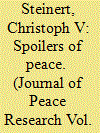

|
|
|
|
|
| Summary/Abstract |
This study investigates how deployment of pro-government militias (PGMs) as counterinsurgents affects the risk of conflict recurrence. Militiamen derive material and non-material benefits from fighting in armed conflicts. Since these will likely have diminished after the conflict’s termination, militiamen develop a strong incentive to spoil post-conflict peace. Members of pro-government militias are particularly disadvantaged in post-conflict contexts compared to their role in the government’s counterinsurgency campaign. First, PGMs are usually not present in peace negotiations between rebels and governments. This reduces their commitment to peace agreements. Second, disarmament and reintegration programs tend to exclude PGMs, which lowers their expected and real benefits from peace. Third, PGMs might lose their advantage of pursuing personal interests while being protected by the government, as they become less essential during peacetimes. To empirically test whether conflicts with PGMs as counterinsurgents are more likely to break out again, we identify PGM counterinsurgent activities in conflict episodes between 1981 and 2007. We code whether the same PGM was active in a subsequent conflict between the same actors. Controlling for conflict types, which is associated with both the likelihood of deploying PGMs and the risk of conflict recurrence, we investigate our claims with propensity score matching, statistical simulation, and logistic regression models. The results support our expectation that conflicts in which pro-government militias were used as counterinsurgents are more likely to recur. Our study contributes to an improved understanding of the long-term consequences of employing PGMs as counterinsurgents and highlights the importance of considering non-state actors when crafting peace and evaluating the risk of renewed violence.
|
|
|
|
|
|
|
|
|
|
|
|
|
|
|
|
|
|
|
|
|